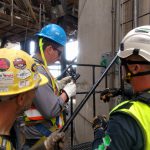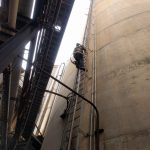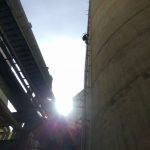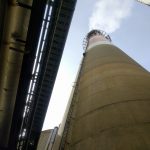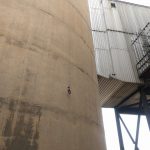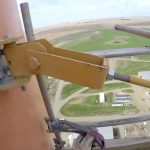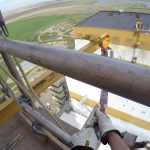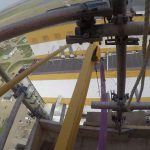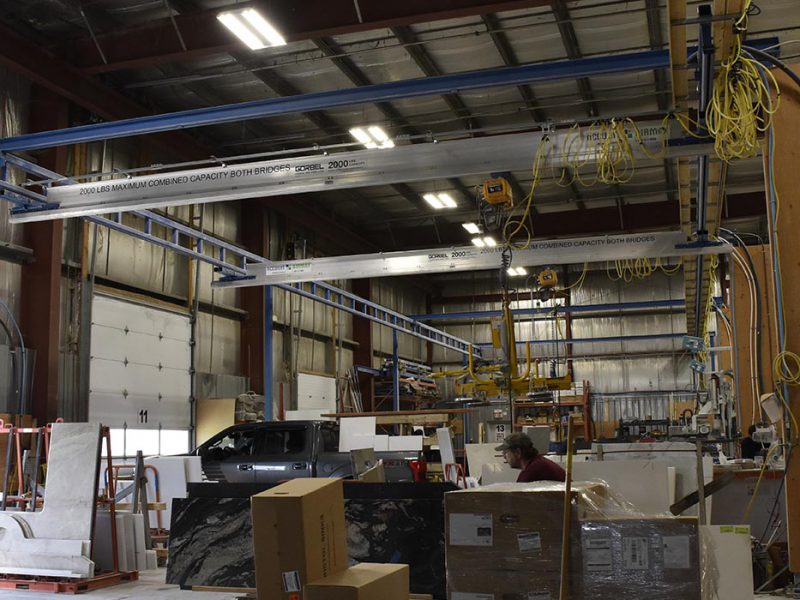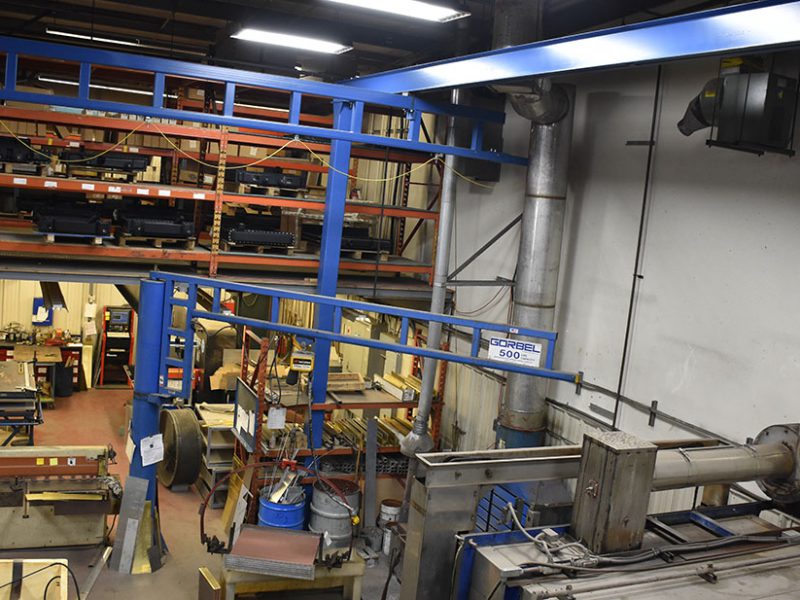Load testing of a jib crane – way up there.
All cranes need to be load tested prior to use, ensuring that they are ready for daily operation. Load testing is an absolutely vital component of our services to our customers to create the safest lifting solution possible. And when that crane is at the top of a 410′ tower (the crane was at the 300-foot level) in Coronach, SK, – you can be assured we take safety very, very, seriously.
The CHALLENGE
Our crew is used to working at heights, after all, we install overhead lifting solutions all the time, but there is a very real difference working forty feet up inside a building, to working 320 feet off the ground in an open air environment. Additional training was needed for this job prior to commencement to ensure safe people and operations at all times.
The PROCESS
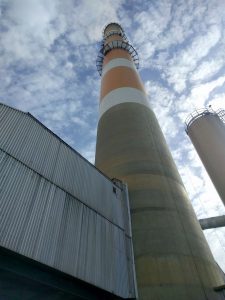 Our crew, well versed in fall arrest, underwent additional training and testing for this job. Training for working at this site was provided by a high angle rescue team from Thurber Rescue. Our crew was trained on how to climb correctly, where to tie off, what to do if there’s an incident and drop prevention strategies. From the start, our crew knew this was a much different situation than they normally face – or as a representative from Thurber put it, “you only have one chance up here.”
Our crew, well versed in fall arrest, underwent additional training and testing for this job. Training for working at this site was provided by a high angle rescue team from Thurber Rescue. Our crew was trained on how to climb correctly, where to tie off, what to do if there’s an incident and drop prevention strategies. From the start, our crew knew this was a much different situation than they normally face – or as a representative from Thurber put it, “you only have one chance up here.”
Our crew faced many challenges on this job, including climbing up a 300’ ladder, not dropping anything, and overcoming the reality of being that high off the ground in an open air environment. The climb up took over 14 minutes (the climb down over 17 minutes) with the advice “don’t look down” being observed at all times to prevent vertigo. All items were secured to our crew – even the smallest object falling from that height could be extremely dangerous for anyone on the ground. Special precautions were taken to ensure everything was secure at all times during the deflection measurements of the crane under load. And lastly, only the determination to get the job done right will help you deal with the wide expanse and open air of being 300 feet off of the ground.
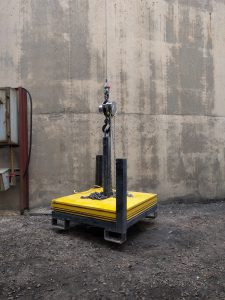 For the guys on the ground who were securing and measuring the test load as it was lifted the biggest challenge was the wind. Controlling a 300 foot 5/16″ cable being push around by the wind was a concern, however; the test load was of sufficient weight that once the cable was attached the wind was no longer an issue.
For the guys on the ground who were securing and measuring the test load as it was lifted the biggest challenge was the wind. Controlling a 300 foot 5/16″ cable being push around by the wind was a concern, however; the test load was of sufficient weight that once the cable was attached the wind was no longer an issue.
Upon reaching the crane after the long climb our crew got to work.
Our technician installed a KITO I-beam trolley onto the jib crane. Once the trolley was installed, a custom, certified, 285-foot wire rope was installed to the bottom of the trolley. Our technician ensured it was safe and started lowering the cable, hand over hand, to the bottom. The cable was about 5 feet from the ground once fully lowered. On the ground, another Acculift technician assembled an Ingersoll Rand manual chain hoist on the bottom of the wire rope. The manual chain hoist was then attached to the Acculift test weights to begin load testing. All the while, there was radio communication between top and bottom to ensure everybody involved knew what was happening, as hand signals at that distance are useless.
All cranes bend (called deflection) a very small amount under load and part of a load test is measuring this deflection to ensure it is within established parameters. Laser measuring tools were used on the half ton wall mounted jib crane while under load and without a load to calculate the deflection. The laser casts a beam from a stationary point on the platform out to the end of the jib crane. A measuring tool was secured to the end of the crane and as the crane deflected, the technicians noted the actual distance deflected during different loads – no load, 100% capacity, and 125% capacity loads.





